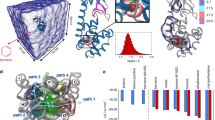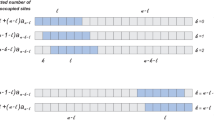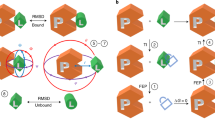Abstract
The binding of ligands to proteins often occurs at rates that approach the diffusion-controlled limit1. For spherical molecules with negligible interactions apart from isotropic reactivity on contact, the diffusion-controlled rate constant is KD≡ 4πRD, where R is the distance between molecular centres at contact and D is the relative translational diffusion constant1–3. Deviations from this limiting rate due to interaction potentials4,5, hydrodynamic interactions6,7 and static geometric features of the binding sites8–13 have previously received much attention. Here, we point out another possible cause of such deviations, the dynamic modulation of binding site accessibility due to internal motions of the protein. Such motions may occur, for example, in proteins such as lysozyme, in which the active site cleft opens and closes in a stochastic manner14,15.
This is a preview of subscription content, access via your institution
Access options
Subscribe to this journal
Receive 51 print issues and online access
$199.00 per year
only $3.90 per issue
Buy this article
- Purchase on Springer Link
- Instant access to full article PDF
Prices may be subject to local taxes which are calculated during checkout
Similar content being viewed by others
References
Cantor, C. R. & Schimmel, P. R. Biophysical Chemistry Pt 3 (Freeman, San Francisco, 1980).
Noyes, R. M. in Progress in Reaction Kinetics Vol. 1, Ch. 5 (Pergamon, New York, 1961).
Smoluchowski, M. v. Phys. Z. 17, 557–584 (1916).
Debye, P. Trans. electrochem. Soc. 82, 265–270 (1943).
Northrup, S. H. & Hynes, J. T. J. chem. Phys. 71, 871–883 (1979).
Deutch, J. M. & Felderhof, B. U. J. chem. Phys. 59, 1669–1671 (1973).
Wolynes, P. G. & McCammon, J. A. Macromolecules 10, 86–87 (1977).
Solc, K. & Stockmayer, W. H. J. chem. Phys. 54, 2981–2988 (1971).
Scheider, W. J. phys. Chem. 76, 349–361 (1972).
Schmitz, K. S. & Schurr, J. M. J. phys. Chem. 76, 534–545 (1972).
Doi, M. Chem. Phys. 11, 115–121 (1975).
Hill, T. L. Proc. natn. Acad. Sci. U.S.A. 72, 4918–4922 (1975).
Samson, R. & Deutch, J. M. J. chem. Phys. 68, 285–290 (1978).
McCammon, J. A., Gelin, B. R., Karplus, M. & Wolynes, P. G. Nature 262, 325–326 (1976).
McCammon, J. A. & Wolynes, P. G. J. chem. Phys. 66, 1452–1456 (1977).
Ptitsyn, O. B. FEBS Lett. 93, 1–4 (1978).
Beece, D. et al. Biochemistry 19, 5147–5157 (1980).
Neher, E. & Stevens, C. F. A. Rev. Biophys. Bioengng 6, 345–381 (1977).
Author information
Authors and Affiliations
Rights and permissions
About this article
Cite this article
McCammon, J., Northrup, S. Gated binding of ligands to proteins. Nature 293, 316–317 (1981). https://doi.org/10.1038/293316a0
Received:
Accepted:
Issue Date:
DOI: https://doi.org/10.1038/293316a0
This article is cited by
-
Conformational gating, dynamics and allostery in human monoacylglycerol lipase
Scientific Reports (2020)
-
Gated Diffusion-controlled Reactions
BMC Biophysics (2011)
Comments
By submitting a comment you agree to abide by our Terms and Community Guidelines. If you find something abusive or that does not comply with our terms or guidelines please flag it as inappropriate.



